Response of Vegetation and Soil Characteristics to Grazing Disturbance in Mountain Meadows and Temperate Typical Steppe in the Arid Regions of Central Asian, Xinjiang
Abstract
1. Introduction
2. Materials and Methods
2.1. Study Area
2.2. Field Sampling and Laboratory Analysis
2.2.1. Experimental Design
2.2.2. Measures indicators
2.3. Data Processing
3. Results
3.1. Soil Physical Properties
3.2. Soil Chemical Properties
3.3. Vegetation Nutrients
4. Discussion
4.1. Effects of Grazing on Soil Physical Properties
4.2. Effect of Grazing on Soil Chemical Properties
4.3. Effects of Grazing on Plant Properties
5. Conclusions
Supplementary Materials
Author Contributions
Funding
Conflicts of Interest
Abbreviations
References
- Suttie, J.M.; Reynolds, S.G.; Batello, C. Grasslands of the world. In Plant Production and Protection Series No. 34; Food and Agriculture Organization of the United Nations: Rome, Italy, 2012. [Google Scholar]
- Piao, S.L.; Fang, J.Y.; Ciais, P.; Huang, Y.; Sitch, S.; Wang, T. The carbon balance of terrestrial ecosystems in China. Nature 2009, 458, 1009–1013. [Google Scholar] [CrossRef]
- Nan, Z. The grassland farming system and sustainable agricultural development in China. Grassl. Sci. 2005, 51, 15–19. [Google Scholar] [CrossRef]
- Chai, L.R.; Sun, Y.; Wang, H.; Chang, S.H.; Hou, F.J.; Cheng, Y.X. Effect of yak grazing intensity on characteristics of plant communities and forage quality in Gannan alpine meadow. Pratacultural Sci. 2018, 35, 18–26. (In Chinese) [Google Scholar]
- Abdalla, M.; Hastings, A.; Chadwick, D.R.; Jones, D.L.; Evans, C.D.; Jones, M.B.; Rees, R.M.; Smith, P. Critical review of the impacts of grazing intensity on soil organic carbon storage and other soil quality indicators in extensively managed grasslands. Agr. Ecosyst. Environ. 2018, 253, 62–81. [Google Scholar] [CrossRef] [PubMed]
- Dec, D.; Dörner, J.; Balocchi, O.; López, I. Temporal dynamics of hydraulic and mechanical properties of an Andosol under grazing. Soil Tillage Res. 2012, 125, 44–51. [Google Scholar] [CrossRef]
- Mueller, L.; Schindler, U.; Mirschel, W.; Shepherd, T.; Ball, B.; Helming, K.; Rogasik, J.; Eulenstein, F.; Wiggering, H. Assessing the productivity function of soils. In Sustainable Agriculture; Springer: Dordrecht, The Netherlands, 2011; Volume 2, pp. 743–760. [Google Scholar]
- Asadi, H.; Raeisvandi, A.; Rabiei, B.; Ghadiri, H. Effect of land use and topography on soil properties and agronomic productivity on calcareous soils of a semiarid region, Iran. Land Degrad. Dev. 2011, 23, 496–504. [Google Scholar] [CrossRef]
- Rita, A.; Lin, Z.; Xiang, L.; Bahadur, R.B. Leaf δ13C as an indicator of water availability along elevation gradients in the dry Himalayas. Ecol. Indicat. 2018, 942, 266–273. [Google Scholar]
- Bonetti, J.A.; Anghinoni, I.; Gubiani, P.I.; Cecagno, D.; de Moraes, M.T. Impact of a long-term crop-livestock system on the physical and hydraulic properties of an Oxisol. Soil Tillage Res. 2019, 186, 280–291. [Google Scholar] [CrossRef]
- Piñeiro, G.; Paruelo, J.M.; Oesterheld, M.; Jobbágy, E.G. Pathways of grazing effects on soil organic carbon and nitrogen. Rangel. Ecol. Manag. 2010, 63, 109–119. [Google Scholar] [CrossRef]
- Bai, Y.F.; Wu, J.G.; Clark, C.M.; Pan, Q.M.; Zhang, L.X.; Chen, S.P.; Wang, Q.B.; Han, X.G. Grazing alters ecosystem functioning and C:N:P stoichiometry of grasslands along a regional precipitation gradient. J. Appl. Ecol. 2012, 49, 1204–1215. [Google Scholar] [CrossRef]
- Radford, B.J.; Yule, D.F.; Braunack, M.; Playford, C. Effects of grazing sorghum stubble on soil physical properties and subsequent crop performance. Am. J. Agric. Biol. Sci. 2008, 3, 734–742. [Google Scholar] [CrossRef][Green Version]
- Li, Y.Q.; Zhao, H.L.; Zhao, X.Y.; Zhang, T.H.; Li, Y.L.; Cui, J.Y. Effects of grazing and livestock exclusion on soil physical and chemical properties in desertifed sandy grassland, inner Mongolia, northern China. Environ. Earth Sci. 2011, 63, 771–783. [Google Scholar] [CrossRef]
- Li, W.; Liu, Y.Z.; Wang, J.L.; Shi, S.L.; Cao, W.X. Six years of grazing exclusion is the optimum duration in the alpine meadow-steppe of the north-eastern Qinghai-Tibetan Plateau. Sci. Rep. 2018, 8, 17269. [Google Scholar] [CrossRef] [PubMed]
- Hao, Y.Q.; He, Z.W. Effects of grazing patterns on grassland biomass and soil environments in China: A meta-analysis. PLoS ONE 2019, 14, e0215223. [Google Scholar] [CrossRef]
- Eniolorunda, N.B. Assessment of soil quality under different grazing intensities in the rima river floodplain, Kware local government area of Sokoto State, Nigeria. Zaria Geogr. 2019, 25, 51–62. [Google Scholar]
- Mathews, B.W.; Sollenberger, L.E.; Staples, C.R. In vitro digestibility and nutrient concentration of bermudagrass under rotational stocking, continuous stocking and clipping. Commun. Soil Sci. Plant Anal. 1994, 25, 301–317. [Google Scholar] [CrossRef]
- Lin, Y.; Hong, M.; Han, G.; Zhao, M.; Bai, Y.; Chang, S.X. Grazing intensity affected spatial patterns of vegetation and soil fertility in a desert steppe. Agric. Ecosyst. Environ. 2010, 138, 282–292. [Google Scholar] [CrossRef]
- Zhang, X.S. Ecological restoration and sustainable agricultural paradigm of mountain-oasis-ecotone-desert system in the north of the Tianshan Mountains. Acta Bot. Sin. 2001, 43, 1294–1299. (In Chinese) [Google Scholar]
- Zhang, Y.Y.; Zhao, W.Z. Vegetation and soil property response of short-time fencing in temperate desert of the Hexi Corridor, northwestern China. Catena 2015, 133, 43–51. [Google Scholar] [CrossRef]
- Xiong, D.P.; Shi, P.L.; Sun, Y.L.; Wu, J.S.; Zhang, X.Z. Effects of grazing exclusion on plant productivity and soil carbon, nitrogen storage in alpine meadows in Northern Tibet, China. Chin. Geogr. Sci. 2014, 24, 488–498. [Google Scholar] [CrossRef]
- Wang, K.B.; Deng, L.; Ren, Z.P.; Li, J.P.; Shangguan, Z.P. Grazing exclusion significantly improves grassland ecosystem C and N pools in a desert steppe of northwest China. Catena 2016, 137, 441–448. [Google Scholar] [CrossRef]
- Wang, T.W.; Zhang, Z.; Li, Z.B.; Li, P. Grazing management affects plant diversity and soil properties in a temperate steppe in northern China. Catena 2017, 158, 141–147. [Google Scholar] [CrossRef]
- Mekuria, W.; Veldkamp, E. Restoration of native vegetation following exclosure establishment on communal grazing lands in Tigray, Ethiopia. Appl. Veg. Sci. 2012, 15, 71–83. [Google Scholar] [CrossRef]
- Ren, J.; Hu, Z.; Zhao, J.; Zhang, D.; Hou, F.; Lin, H.; Mu, X. A grassland classification system and its application in China. Rangel. J. 2008, 30, 199. [Google Scholar] [CrossRef]
- Bi, X.; Li, B.; Fu, Q.; Fan, Y.; Ma, L.X.; Yang, Z.H.; Nan, B.; Dai, X.H.; Zhang, X.S. Effects of grazing exclusion on the grassland ecosystems of mountain meadows and temperate typical steppe in a mountain-basin system in Central Asia’s arid regions, China. Sci. Total Environ. 2018, 630, 254–263. [Google Scholar] [CrossRef] [PubMed]
- Bao, S.D. Soil Chemical Analysis of Agriculture, 3rd ed.; Chinese Agriculture Press: Beijing, China, 2005; pp. 42–58. (In Chinese) [Google Scholar]
- Marriott, C.A.; Hood, K.; Fisher, J.M.; Pakeman, R.J. Long-term impacts of extensive grazing and abandonment on the species composition, richness, diversity and productivity of agricultural grassland. Agr. Ecosyst. Environ. 2009, 134, 190–200. [Google Scholar] [CrossRef]
- Drewry, J.J.; Paton, R.J. Effects of sheep treading on soil physical properties and pasture yield of newly sown pastures. N. Z. J. Agric. Res. 2005, 48, 39–46. [Google Scholar] [CrossRef]
- Evans, C.R.W.; Krzic, M.; Broersma, K.; Thompson, D.J. Long-term grazing effects on grassland soil properties in southern British Columbia. Can. J. Soil Sci. 2012, 92, 685–693. [Google Scholar] [CrossRef]
- Abril, A.; Bucher, E.H. Overgrazing and soil carbon dynamics in the western Chaco of Argentina. Appl. Soil Ecol. 2001, 16, 243–249. [Google Scholar] [CrossRef]
- Tang, J.; Davy, A.J.; Jiang, D.M.; Musa, A.; Wu, D.F.; Wang, Y.C.; Miao, C.P. Effects of excluding grazing on the vegetation and soils of degraded sparse-elm grassland in the Horqin Sandy Land, China. Agr. Ecosyst. Environ. 2016, 235, 340–348. [Google Scholar] [CrossRef]
- Hamza, M.A.; Anderson, W.K. Soil compaction in cropping systems: A review of the nature, causes and possible solutions. Soil Tillage Res. 2005, 82, 121–145. [Google Scholar] [CrossRef]
- Aldezabal, A.; Moragues, L.; Odriozola, I.; Mijangos, I. Impact of grazing abandonment on plant and soil microbial communities in an Atlantic mountain grassland. Appl. Soil Ecol. 2015, 96, 251–260. [Google Scholar] [CrossRef]
- Zhang, B.; Beck, R.; Pan, Q.; Zhao, M.L.; Hao, X.Y. Soil physical and chemical properties in response to long-term cattle grazing on sloped rough fescue grassland in the foothills of the Rocky Mountains, Alberta. Geoderma 2019, 346, 75–83. [Google Scholar] [CrossRef]
- Li, X.Z.; Chen, Z.Z. Influences of stocking rates on C, N and P contents in plant-soil system. Acta Agrestla Sinca 1998, 6, 90–98. [Google Scholar]
- Chai, J.; Yu, X.; Xu, C.; Xiao, H.; Zhang, J.; Yang, H.L.; Pan, T.T. Effects of yak and Tibetan sheep trampling on soil properties in the northeastern Qinghai-Tibetan Plateau. Appl. Soil Ecol. 2019, 144, 147–154. [Google Scholar] [CrossRef]
- Li, W.; Cao, W.X.; Wang, J.L.; Li, X.L.; Xu, C.L.; Shi, S.L. Effects of grazing regime on vegetation structure, productivity, soil quality, carbon and nitrogen storage of alpine meadow on the Qinghai-Tibetan plateau. Ecol. Eng. 2017, 98, 123–133. [Google Scholar] [CrossRef]
- Ebrahimi, M.; Khosravi, H.; Rigi, M. Short-term grazing exclusion from heavy livestock rangelands affects vegetation cover and soil properties in natural ecosystems of southeastern Iran. Ecol. Eng. 2016, 95, 10–18. [Google Scholar] [CrossRef]
- Jeddi, K.; Chaieb, M. Changes in soil properties and vegetation following livestock grazing exclusion in degraded arid environments of South Tunisia. Flora Morphol. Distrib. Funct. Ecol. Plants 2010, 205, 184–189. [Google Scholar] [CrossRef]
- Cui, X.Y.; Wang, Y.F.; Niu, H.S.; Wu, J.; Wang, S.P.; Schnug, E.; Rogasik, L.; Fleckenstein, J.; Tang, Y.H. Effect of long-term grazing on soil organic carbon content in semiarid steppes in Inner Mongolia. Ecol. Res. 2005, 20, 519–527. [Google Scholar] [CrossRef]
- Xiong, D.P.; Shi, P.; Zhang, X.Z.; Zou, C.B. Effects of grazing exclusion on carbon sequestration and plant diversity in grasslands of China—A meta-analysis. Ecol. Eng. 2016, 94, 647–655. [Google Scholar] [CrossRef]
- Kuzyakov, Y.; Domanski, G. Carbon input by plants into the soil. Rev. J. Plant Nutr. Soil Sci. 2000, 163, 421–431. [Google Scholar] [CrossRef]
- Naeth, M.A.; Bailey, A.W.; Pluth, D.J.; Chanasyk, D.S.; Hardin, R.T. Grazing impacts on litter and soil organic matter in mixed prairie and fescue grassland ecosystems of Alberta. Rangel. Ecol. Manag. J. Range Manag. Arch. 1991, 44, 7–12. [Google Scholar] [CrossRef]
- Frank, D.A.; Kuns, M.M.; Guido, D.R. Consumer control of grassland plant production. Ecology 2002, 83, 602–606. [Google Scholar] [CrossRef]
- Shi, X.M.; Li, X.G.; Li, C.T.; Zhao, Y.; Shang, Z.H.; Ma, Q. Grazing exclusion decreases soil organic C storage at an alpine grassland of the Qinghai–Tibetan Plateau. Ecol. Eng. 2013, 57, 183–187. [Google Scholar] [CrossRef]
- De Deyn, G.B.; Cornelissen, J.H.C.; Bardgett, R.D. Plant functional traits and soil carbon sequestration in contrasting biomes. Ecol. Lett. 2008, 11, 516–531. [Google Scholar] [CrossRef]
- Giese, M.; Brueck, H.; Gao, Y.Z.; Lin, S.; Steffens, M.; Kögel-Knabner, I.; Glindemann, T.; Susenbeth, A.; Taube, F.; Butterbach-Bahl, K.; et al. N balance and cycling of Inner Mongolia typical steppe: A comprehensive case study of grazing effects. Ecol. Monogr. 2013, 83, 195–219. [Google Scholar] [CrossRef]
- Mekuria, W.; Veldkamp, E.; Haile, M.; Muys, B.; Gebrehiwot, K. Effectiveness of exclosures to restore degraded soils as a result of overgrazing in Tigray, Ethiopia. J. Arid Environ. 2007, 69, 270–284. [Google Scholar] [CrossRef]
- Li, G.; Zhang, Z.; Shi, L.L.; Zhou, Y.; Yang, M.; Cao, J.X.; Wu, S.H.; Lei, G.C. Effects of different grazing intensities on soil C, N, and P in an alpine meadow on the Qinghai—Tibetan Plateau, China. Int. J. Env. Res. Public Health 2018, 15, 2584. [Google Scholar] [CrossRef]
- Rui, Y.; Wang, Y.; Chen, C.; Zhou, X.; Wang, S.; Xu, Z.; Duan, J.; Kang, X.; Lu, S.; Luo, C. Warming and grazing increase mineralization of organic P in an alpine meadow ecosystem of Qinghai-Tibet Plateau, China. Plant Soil 2012, 357, 73–87. [Google Scholar] [CrossRef]
- Raliya, R.; Tarafdar, J.C.; Biswas, P. Enhancing the mobilization of native phosphorus in the mung bean rhizosphere using ZnO nanoparticles synthesized by soil fungi. J. Agric. Food Chem. 2016, 64, 3111–3118. [Google Scholar] [CrossRef]
- Zhang, M.; Li, X.B.; Wang, H.; Huang, Q. Comprehensive analysis of grazing intensity impacts soil organic carbon: A case study in typical steppe of Inner Mongolia, China. Appl. Soil Ecol. 2018, 129, 1–12. [Google Scholar] [CrossRef]
- Schlesinger, W.H. An analysis of global change. Biogeochemistry 1997, 2, 40–41. [Google Scholar]
- Kuzyakov, Y. Priming effects: Interactions between living and dead organic matter. Soil Biol. Biochem. 2010, 42, 1363–1371. [Google Scholar] [CrossRef]
- Baggie, I.; Rowell, D.L.; Robinson, J.S.; Warren, G.P. Decomposition and phosphorus release from organic residues as affected by residue quality and added inorganic phosphorus. Agrofor. Syst. 2005, 63, 125–131. [Google Scholar] [CrossRef]
- Steffens, M.; Kölbl, A.; Totsche, K.U.; Kögel-Knabner, I. Grazing effects on soil chemical and physical properties in a semiarid steppe of Inner Mongolia (P.R. China). Geoderma 2008, 143, 63–72. [Google Scholar] [CrossRef]
- Ma, W.M.; Ding, K.Y.; Li, Z.W. Comparison of soil carbon and nitrogen stocks at grazing-excluded and yak grazed alpine meadow sites in Qinghai–Tibetan Plateau, China. Ecol. Eng. 2016, 87, 203–211. [Google Scholar] [CrossRef]
- Bardgett, R.D.; Wardle, D.A.; Yeates, G.W. Linking aboveground and below-ground interactions: How plant responses to foliar herbivory influence soil organisms. Soil Biol. Biochem. 1998, 30, 1867–1878. [Google Scholar] [CrossRef]
- Molvar, E.M.; Bowyer, R.T.; Van Ballenberghe, V. Moose herbivory, browse quality, and nutrient cycling in an Alaskan treeline community. Oecologia 1993, 94, 472–479. [Google Scholar] [CrossRef]
- Vitousek, P.M.; Porder, S.; Houlton, B.Z.; Chadwick, O.A. Terrestrial phosphorus limitation: Mechanisms, implications, and nitrogen-phosphorus interactions. Ecol. Appl. 2010, 20, 5–15. [Google Scholar] [CrossRef]
- Elser, J.J.; Fagan, W.F.; Kerkhoff, A.J.; Swenson, N.G.; Enquist, B.J. Biological stoichiometry of plant production: Metabolism, scaling and ecological response to global change. New Phytol. 2010, 186, 593–608. [Google Scholar] [CrossRef]
- McNaughton, S.J. Compensatory plant growth as a response to herbivore. Oikos 2001, 92, 515. [Google Scholar]
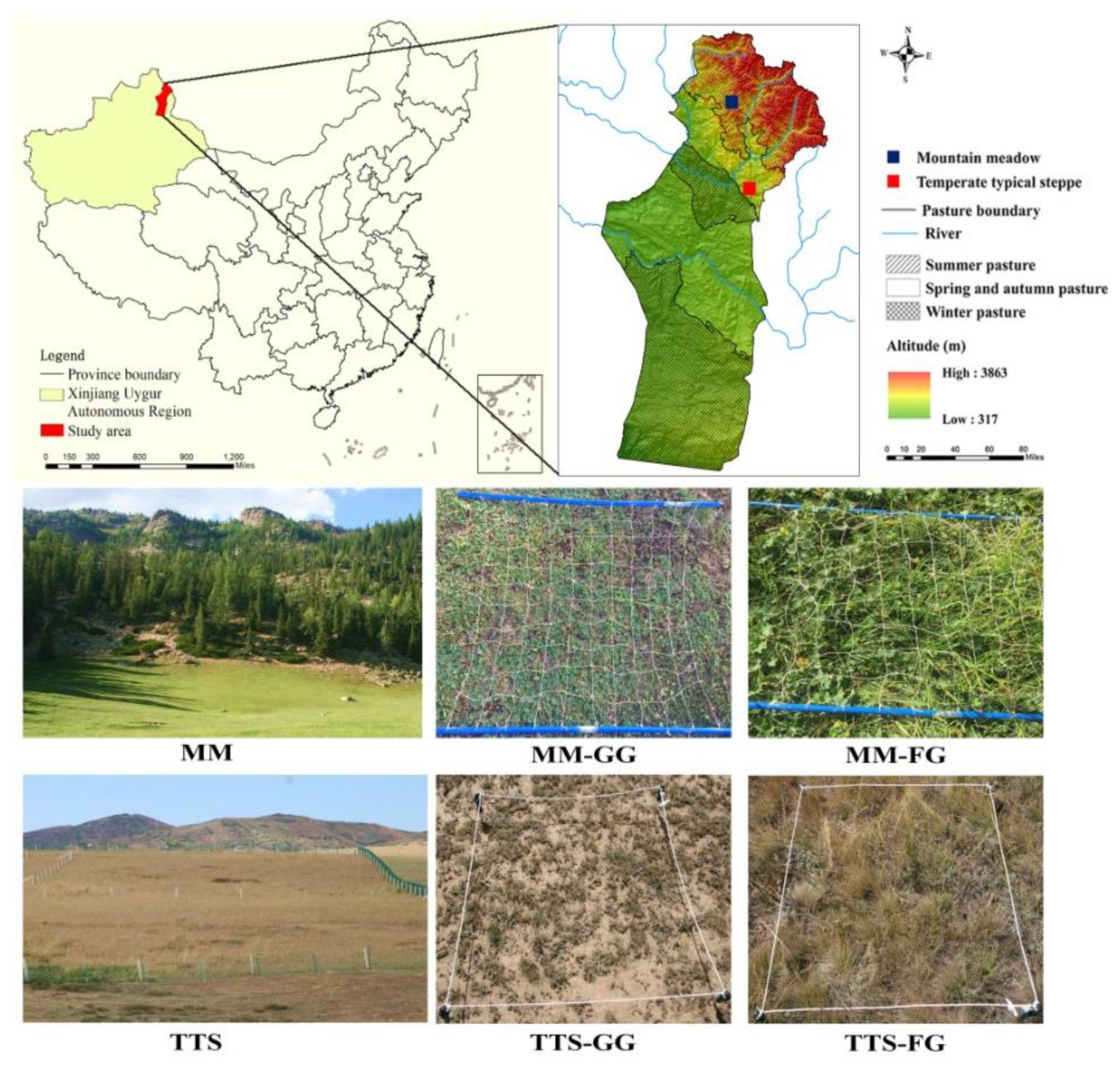
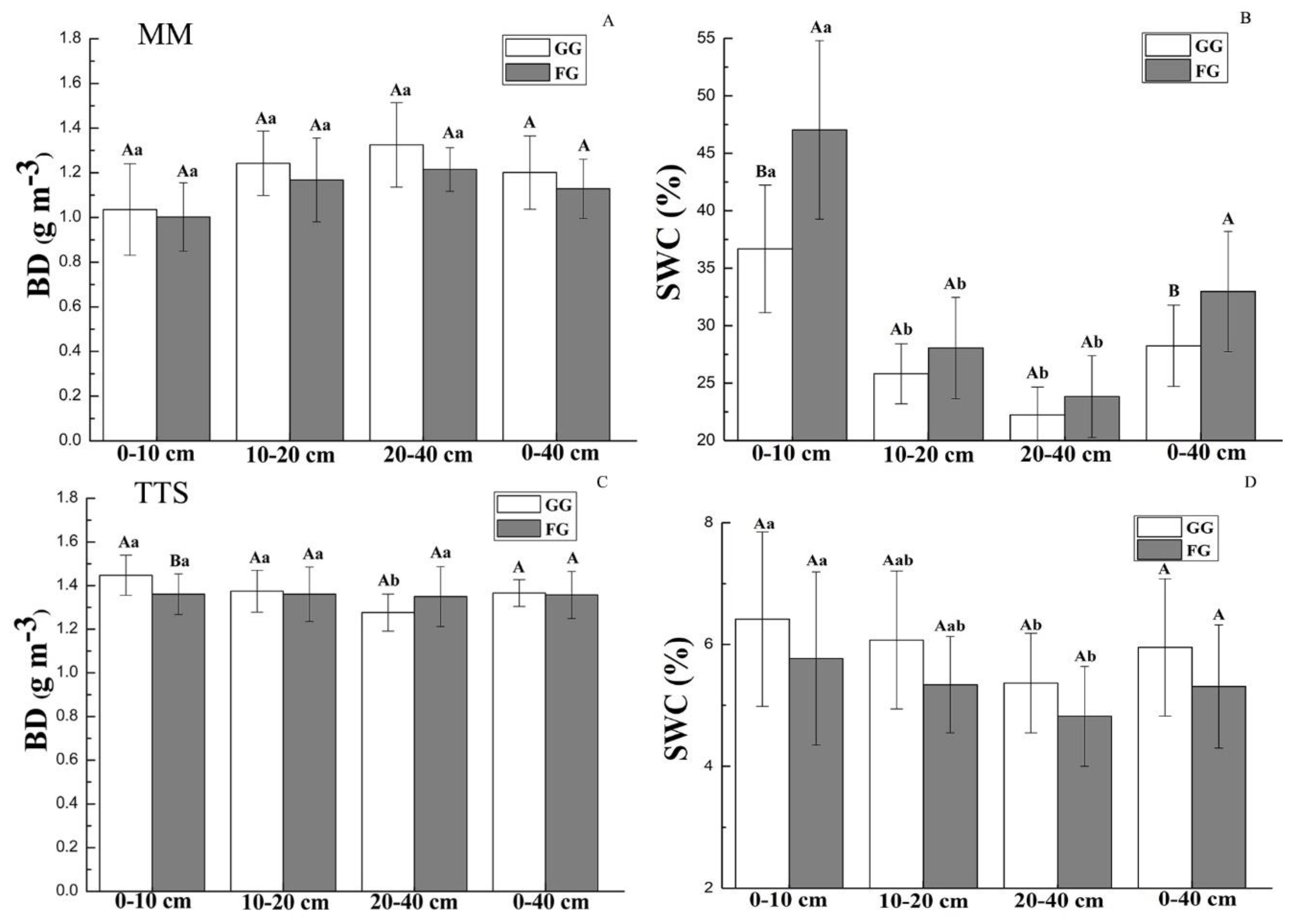

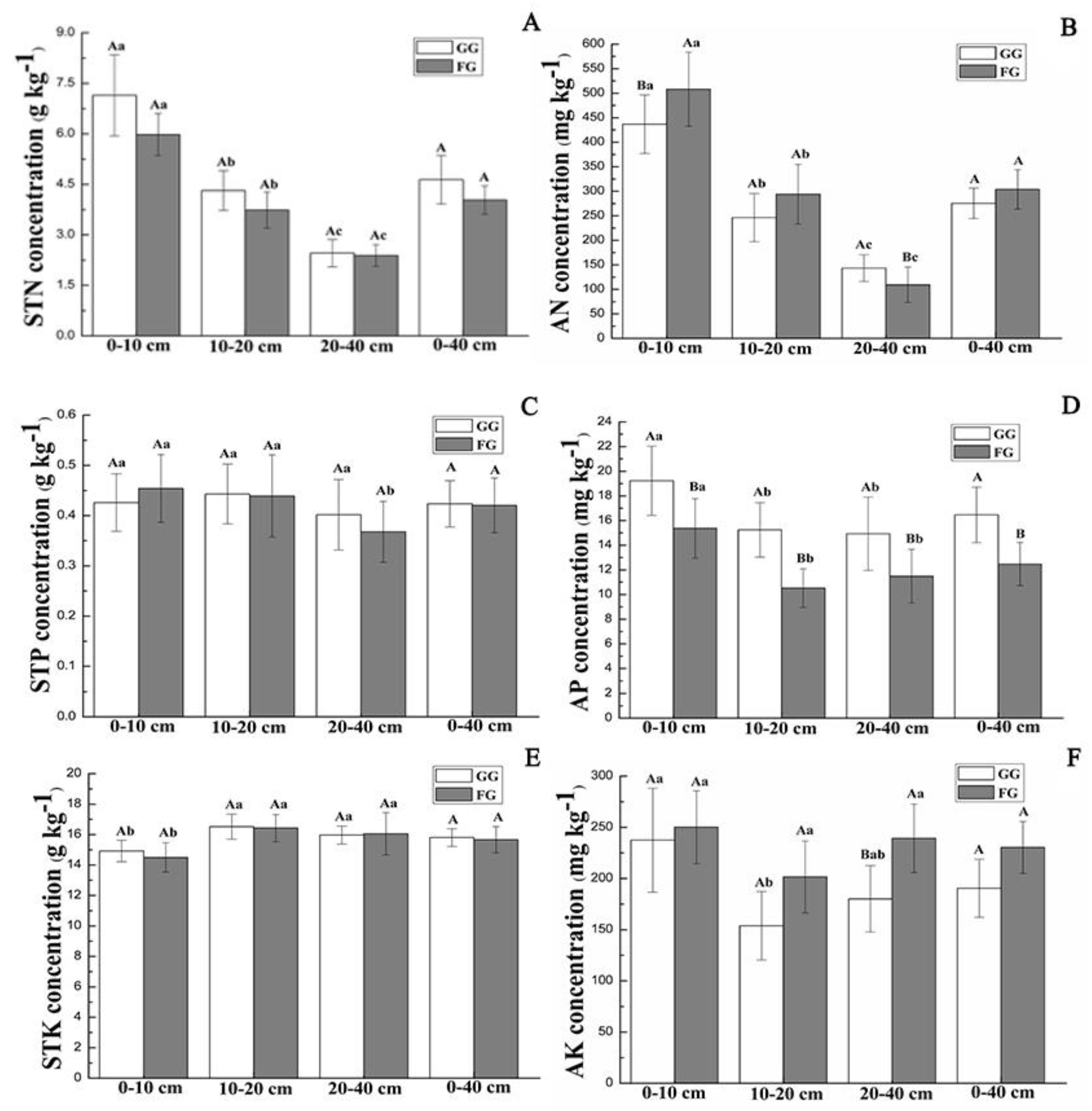
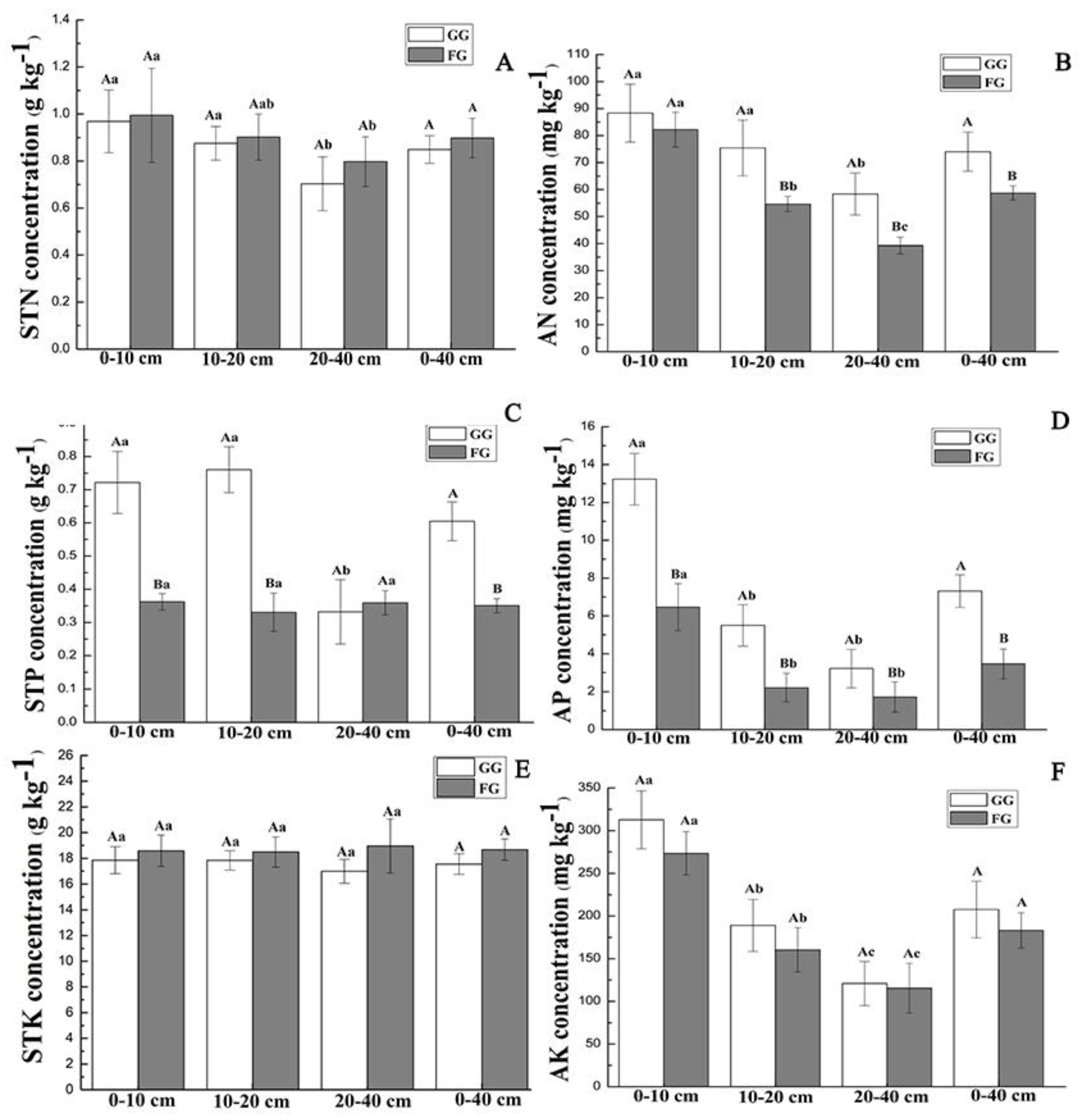
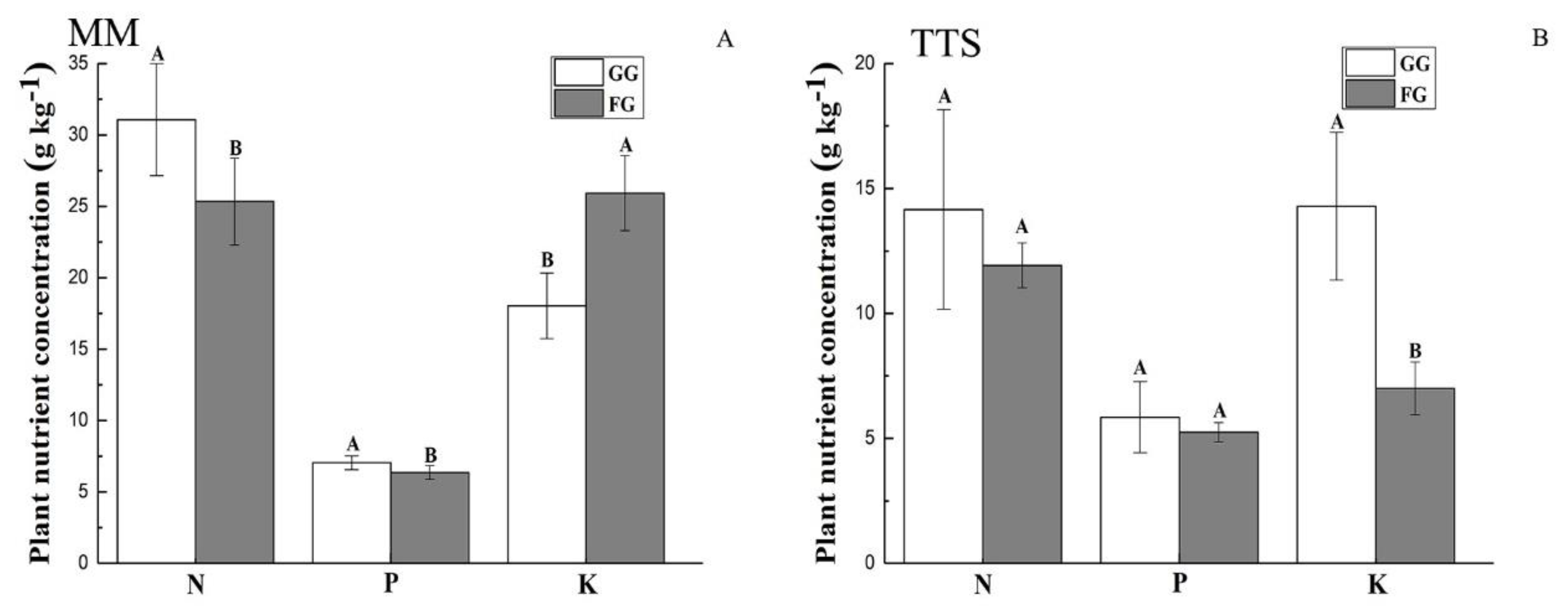
| Sample Plots | Longitude (°) | Latitude (°) | Elevation (m) | MAP (mm) | MAT (°C) | Agrotype | Utilization Period | GPI |
|---|---|---|---|---|---|---|---|---|
| Mountain meadow | 89.41 | 47.57 | 2066 | 359.42 | −1.71 | Mountain meadow soil | Summer | 1.73 |
| Temperate typical steppe | 89.75 | 46.97 | 1414 | 277.06 | 2.23 | Chestnut soil | Spring/autumn | 3.89 |
| Grassland Type | Functional Group | Treatments | Coverage (%) | Above/Belowground Biomass (g·m−2) | Dominant Species |
|---|---|---|---|---|---|
| Mountain meadow | Leguminous species Gramineous Species Sedge species Forbs species | FG | 95 ± 3.83A | 282.5 ± 26.5A (Above) 976.50 ± 67.59B (Below) | Poa angustifolia, Alchemilla pinguis |
| GG | 85.5 ± 5.26B | 65.9 ± 9.51B (Above) 1193.75 ± 90.40A (Below) | Trifolium incarnatum, Alchemilla pinguis | ||
| Temperate typical steppe | Leguminous species Gramineous species Sedge species Semi-shrubs species Forbs species | FG | 68.75 ± 4.79A | 144 ± 4.71A (Above) 1090.68 ± 84.27A (Below) | Artemisia frigida, Festuca ovina |
| GG | 35 ± 4.08B | 64.55 ± 2.83B (Above) 564.07 ± 41.69B (Below) | Artemisia frigida, Kochia prostrata |
© 2020 by the authors. Licensee MDPI, Basel, Switzerland. This article is an open access article distributed under the terms and conditions of the Creative Commons Attribution (CC BY) license (http://creativecommons.org/licenses/by/4.0/).
Share and Cite
Bi, X.; Li, B.; Xu, X.; Zhang, L. Response of Vegetation and Soil Characteristics to Grazing Disturbance in Mountain Meadows and Temperate Typical Steppe in the Arid Regions of Central Asian, Xinjiang. Int. J. Environ. Res. Public Health 2020, 17, 4572. https://doi.org/10.3390/ijerph17124572
Bi X, Li B, Xu X, Zhang L. Response of Vegetation and Soil Characteristics to Grazing Disturbance in Mountain Meadows and Temperate Typical Steppe in the Arid Regions of Central Asian, Xinjiang. International Journal of Environmental Research and Public Health. 2020; 17(12):4572. https://doi.org/10.3390/ijerph17124572
Chicago/Turabian StyleBi, Xu, Bo Li, Xiangchao Xu, and Lixin Zhang. 2020. "Response of Vegetation and Soil Characteristics to Grazing Disturbance in Mountain Meadows and Temperate Typical Steppe in the Arid Regions of Central Asian, Xinjiang" International Journal of Environmental Research and Public Health 17, no. 12: 4572. https://doi.org/10.3390/ijerph17124572
APA StyleBi, X., Li, B., Xu, X., & Zhang, L. (2020). Response of Vegetation and Soil Characteristics to Grazing Disturbance in Mountain Meadows and Temperate Typical Steppe in the Arid Regions of Central Asian, Xinjiang. International Journal of Environmental Research and Public Health, 17(12), 4572. https://doi.org/10.3390/ijerph17124572





